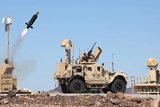Netherlands acquires more AIM-9X Sidewinder missiles from US
The Sidewinder missile can be operated from a range of aircraft, including this Dutch F-16. (Photo: Royal Netherlands Air Force)
The Netherlands has requested to buy 72 AIM-9X Block II Tactical Missiles, 43 AIM-9X Block II+ Missiles and one AIM-9X Block II+ Tactical Guidance Unit that will be added to a previously implemented case.
The original FMS case, valued at $16.8 million, included 23 AIM-9X Block II missiles.
This notification amounts to a total 95 AIM-9X Block II Missiles, 43 AIM-9X Block II+ missiles and one AIM-9X Block II+ Tactical Guidance Unit.
Also included are containers, software, technical assistance and other related logistical and programme support.
The sale will enable the Royal Netherlands Air Force to provide stronger support for the Netherlands’ air defence needs.
The Dutch Air Force already operates the AIM-9 Sidewinder, according to Shephard Defence Insight, the nation has ordered over 2000 of the AAM
The Air Force operates the AAM from its current fleet of 61 F-16s and 15 F-35s, with a total of 46 F-35s ordered by the nation.
Related Equipment in Defence Insight
More from Air Warfare
-
![How do we detect and defeat enemy drones?]()
How do we detect and defeat enemy drones?
Learn about the portfolio of sensors and effectors for the complete counter-UAS mission at Raytheon, an RTX business.
-
![BAE Systems lauds counter-UAS drone progression with live fire trials]()
BAE Systems lauds counter-UAS drone progression with live fire trials
The US-based tests successfully demonstrated the first live trial of a precision guided missile from a modified TRV-150 drone which destroyed both aerial and ground targets.
-
![Kratos Defense makes European CCA push with Airbus partnership]()
Kratos Defense makes European CCA push with Airbus partnership
Kratos’ XQ-58A Valkyrie will be equipped with an Airbus-made mission system to be offered as a ‘European’ collaborative combat aircraft option to the German Air Force.
-
![Anduril’s Barracuda-100M completes latest successful test flights]()
Anduril’s Barracuda-100M completes latest successful test flights
The munitions variant of the Barrauda-100 autonomous air vehicle is being tested for the US Army’s High-Speed Manoeuvrable Missile (HSMM) testbed programme, with further flight tests expected in 2026.






















